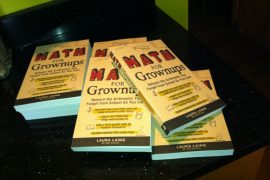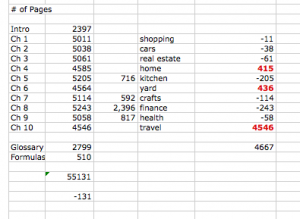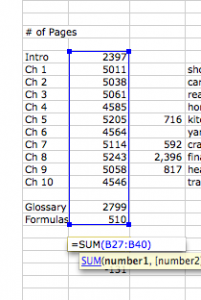November 2011, I knew I had my work cut out for me. First off, I had never written a book before. Writing 800-word stories paled in comparison to the 55,000 words I was expected to produce for this book. Second, I had only 8 weeks to pull off this gargantuan task — and right smack dab in the middle of them were the winter holidays: Christmas, Hanukkah, Winter Solstice and New Years.
Looking back, I think I must have been insane.
But this book wasn’t just any old book. I knew I could crank out the ideas, because they’d been sitting in my head for years and years. Still, I was nervous.
So what did I do? Well, I turned to my old friend math, of course.
I knew I was probably going to write chapter by chapter. But how many words should each chapter be? I was contracted to write 10 chapters, plus an introduction. I also wanted to include a glossary and an appendix with formulas. Just as a starting point, I figured the introduction, glossary and appendix would be about the same length as one chapter. So that meant I was dividing the entire word count by 11.
55,000 words ÷ 11 chapters = 5,000 words/chapter
Each chapter needed to be about 5,000 words long. Convenient, eh? Suddenly those 55,000 words were simply 11 5,000-word “stories.” I’d written 6,000-word stories before, so I knew I could manage this!
Then I had to look at my timeline: 8 weeks. I didn’t want to write during the week of the Christmas holiday, so I really had only 7 weeks. But one chapter was pretty much done, since I had to turn it in with my proposal.
Clearly, I couldn’t write one chapter each week. With 11 “chapters” (if I considered my introduction, glossary and appendix as a chapter), I was going to need to double up. I had already planned to work 7 days a week, if necessary, so I did some more math to figure out the total number of days I’d be writing the ten remaining chapters.
7 weeks x 7 days = 49 days
And a little more math to figure out the number of days I had to write each chapter.
49 days ÷ 10 chapters = 4.9 days/chapter
To be realistic, I decided to bet on 4 days per chapter. That would give me a couple of days off here and there.
I did fine with this plan, until mid-December. I slowed down considerably, and by the start of 2011, I was behind. Panic set in. So I turned to math yet again. This time, I pulled out the big guns: a spreadsheet.
I don’t have a screenshot of what my book spreadsheet looked like originally. The above is how it ended up. But I can tell you this: when I was really feeling nervous about my progress, I checked my word count and updated my spreadsheet — sometimes several times in an hour — just to see the numbers change.
You see, in some of the fields are formulas that add or subtract to show my word count. Here’s an example:
I used the SUM function to add up everything in the blue box — in other words, my actual word count for each chapter. When I changed a value in the blue box, the total pages changed as well. Here’s another example:
Here, I’ve subtracted the word count for the chapter on yard work from 5,000 (or my estimate word count for each chapter). Each time I updated my word count for that chapter, the difference changed.
Yeah, this is really, really geeky, I’ll grant you that! And I know it takes a “special” brain to love spreadsheets this much. But I do think it’s an effective way to set goals and get yourself motivated.
So if you’re worried about how you’ll ever finish writing that book or make all of those quilt squares or whatever your big project is, consider how math can help. It just might get you organized enough to get started. (Or it might give you the distraction you need to settle your nerves.)
When have you used math to help you get through a daunting project? Share your story in the comments section!



